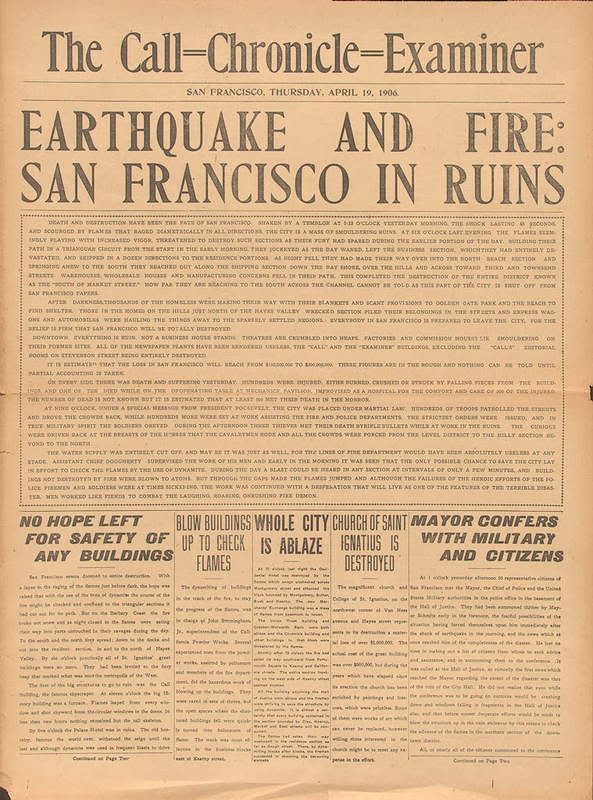
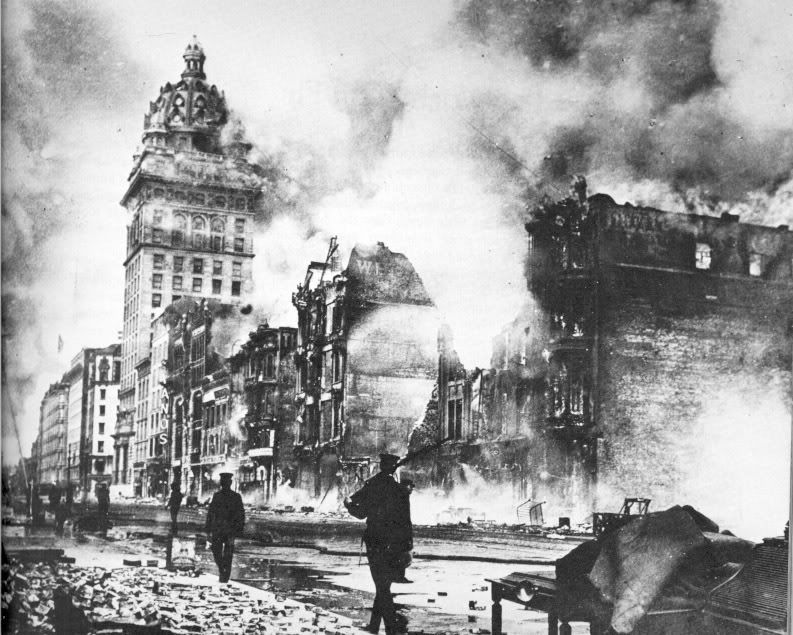
The San Francisco earthquake of 1906 was a major earthquake that struck San Francisco and the coast of northern California at 5:12 A.M. on Wednesday, April 18 1906. The most widely accepted estimate for the magnitude of the earthquake is a moment magnitude (Mw) 7.8; however, other values have been proposed from 7.7 to as high as 8.3.[1] The mainshock epicenter occurred offshore about 2 miles (3 km) from the city. It ruptured along the San Andreas Fault both northward and southward for a total length of 296 miles (477 km).[2] Shaking was felt from Oregon to Los Angeles, and inland as far as central Nevada. The earthquake and resulting fire is remembered as one of the worst natural disasters in the history of the United States. The toll from the earthquake and resulting fire represents the greatest loss of life from a natural disaster in California's history.
http://www.answers.com/topic/1906-san-francisco-earthquake
On April 18, 1906, a devastating earthquake struck San Francisco, followed by raging fires; estimates of the final death toll stood at more than 3,600.

Rebel Science: San Francisco earthquake recalled
“Not in history has a modern imperial city been so completely destroyed. San Francisco is gone.”
These sentiments, penned by literary giant and San Francisco native, Jack London, were shared by many who witnessed the Great 1906 San Francisco Earthquake.
Although this was one of the most destructive quakes in recorded history, it failed to discourage the rebuilding of the city, but instead helped further the understanding of the tremor’s source: the San Andreas fault.
In the early spring of 1906, the bustling city of San Francisco was home to more than 400,000 residents and was deemed by tourists as the “Gateway to the Pacific.” However, the city and surrounding area endured a major setback 101 years ago on the morning of April 18, 1906, when an estimated 7.8 magnitude earthquake struck.
According to the United States Geological Survey website, eyewitness reports claim that a steady, 40 to 60 second period of shaking, interrupted by periodic, violent jolts rocked the cities of San Francisco, Santa Rosa and San Jose. Death and destruction were left in the wake. The quake released so much energy that it was felt as far north as Oregon, south of L. A. and as far east as central Nevada.
At the time of the earthquake, San Francisco, although regarded as the financial and cultural hub of the West, was quite young and still a budding metropolis. Less than 60 years prior, it had been a sleepy harbor town with a population of less than 1,000. The relatively short-lived California Gold Rush of 1848-55 quickly transformed it into a busy and rowdy city of 25,000 fortune seekers virtually overnight. However, it was the lengthy and steady flow of gold and silver mined from the Comstock Lode in Virginia City, Nevada, that gave San Francisco its sophistication and wealth.
In 1859, a zone of gold and silver veins 0.5 miles wide and 7 miles long was discovered in the mountains of neighboring Northern Nevada.
The Bank of California made loans to the early upstart mining companies, many of which defaulted before striking the heart of the “lode.” This made the San Francisco-based bank the second richest in the nation as, over the course of 20 years, $5 billion (in today’s money) was extracted from Virginia City. Much of this was invested in building San Francisco.
By 1906, San Francisco was the ninth largest city in the nation and the largest on the West coast. Although its natural bay was ideal for industry, the location was and remains adjacent to one of the most active and widely studied faults in the world: the San Andreas.
Discovered and named by a UC Berkeley geology professor in 1895, the San Andreas is a transform, strike-slip fault that runs 800 miles across the length of California.
The San Andreas is unique in that it is not only a fault but also a tectonic plate boundary. Extending deep within the lithosphere (crust and upper mantle), the San Andreas’ fissure marks where the North American plate and the Pacific plate essentially rub past one another. Although virtually no crust is created or destroyed at this interface, (known as a transform plate boundary), movement of the crust does occur and can be felt in the form of earthquakes.
According to the USGS, the 1906 quake that woke the city of San Francisco was centered off of the coast and ruptured at a length of 296 miles along the fault.
The rupture propagated at speeds of approximately 5,800 mph. In some areas, large, horizontal displacements of the land were obvious as railroad tracks, fences and roadways straddling the fault were offset as much as 20 feet.
According to early geological reports, structures built atop soft sediment reclaimed from San Francisco Bay suffered the greatest damage, while those constructed upon bedrock underwent minimal devastation.
Initial reports documented death tolls in the upper 300s to 400s. However, it is generally believed by historians today that these figures were fabricated by city and state officials who feared that publicizing the truth would not only invoke additional panic among locals, but also tarnish the nation’s image of San Francisco. In the midst of a devastated city and with a massive revitalization project ahead of them, leaders called no attention to facts that would cripple land values and scare off present and future residents.
The sad fact appears that approximately 3,000 lives were lost either directly or indirectly as a result of the quake according to extensive research released in the 1989 publication, “Denial of a Disaster.” Reportedly, most deaths occurred in the heart of the densely populated city, with hundreds of casualties, ignored by officials, occurred in Chinatown. Approximately 500 of the total count were killed by law enforcement after the quake for allegedly looting damaged buildings.
According to Wikipedia.org, the 1906 earthquake’s death count holds the record as California’s worst resulting from a natural disaster.
Although details of the catastrophe were withheld from the public, the enormity of the destruction was not, thanks in part to the presence of a relatively new invention known as the motion picture camera. The Great San Francisco Earthquake, along with the Galveston Hurricane of 1900, were the first natural disasters documented by motion picture and turned into newsreels, enabling concerned Americans across the country to witness and judge for themselves the extent of the devastation.
Over 28,000 buildings were destroyed by the quake and/or the subsequent fires that ravaged the city, leaving over 225,000 San Franciscans homeless. The fires are believed to have started from ruptured gas mains, the campfires of refugees and/or the hands of arsonists. Although earthquake damage was excluded from coverage under most insurance polices, fire damage was not; hence, it is suspected that many toppled buildings were deliberately set ablaze by their owners. Property damage estimates from the disaster made by the National Oceanic and Atmospheric Administration stand at approximately $6.5 billion in today’s money.
Unfortunately, in addition to the gas, the city’s water mains also broke from the shifting ground, leaving firemen and U.S. Army relief troops virtually powerless against the flames. Reportedly, several of the fires merged, creating an inferno that charred over 500 city blocks (4.7 square miles) of the downtown area and burned right down to the docks. In order to mimic the water’s role as a firebreak and save remaining districts, city leaders ordered the detonation and demolition of city blocks to encircle and “starve” the conflagration. According to Wikipedia.org, 80 percent of the city was destroyed.
Although the city was quickly rebuilt by 1915, much of the earlier industry and population had relocated to L.A., an area just 34 miles southwest of the San Andreas.
Immediately after the 1906 quake, geologists in California scrambled to understand its cause. A state earthquake investigation commission was assembled which laid the groundwork for the 100 years of earthquake research that followed.
As reported by the USGS Web site, with the exception of a 6.5 in 1911, the 1906 quake essentially halted, for 70 years, all earthquakes in the Bay area that exceeded a magnitude of 6.0. It is thought that the 1906 rupture actually redistributed stress throughout the length of the San Andreas’ fault plane (movement surface) and relaxed the stress which numerous parallel faults were under.
It has been found that the earth’s crust elastically distorts with years of gradual plate movement along the San Andreas. Over the years, the stress builds until it is suddenly released by a rapid slip along the fault, generating high magnitude quakes. Although these large earthquakes are separated by years of “quiet” stress buildup, according to the USGS, there is reason to believe that these periods of seismic quiescence are common and relatively short-lived.
A 1984 study conducted by the California Institute of Technology excavated a segment of the San Andreas fault northeast of L.A. From the displaced and overlapping layers of sediment deposited within the fissure, researchers concluded that repeated movement has occurred over the centuries. Evidence was found that at least five earthquakes occurring between 260 A.D. and 1857 produced horizontal displacements similar to or greater than those of the 1906 quake.
It been hypothesized that Northern California’s segments of the San Andreas are slowly returning to pre-1906 stress levels as the tectonic plates move at rates of approximately 33-37 millimeters per year. According to the USGS, there is a 62 percent chance of a 6.7 magnitude earthquake (or greater) occurring between 2003 and 2032 in the Bay region.
Although understanding California’s faults and our estimates of their future behavior are improving, the potential danger posed by these features is just as severe. San Francisco is now home to over 730,000 people and continues to grow. By being aware of the behavior of the ground below and taking the necessary precautions when further developing the Bay area, we can hope that the 1906 earthquake will never be surpassed in terms of destruction and human loss.
San Francisco Quake—Then and Now
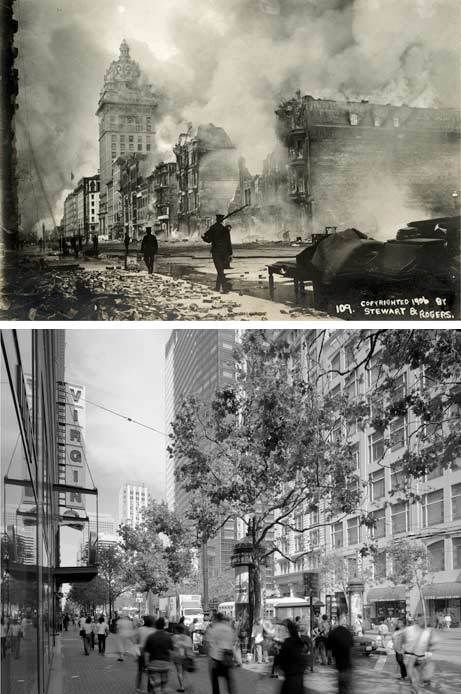
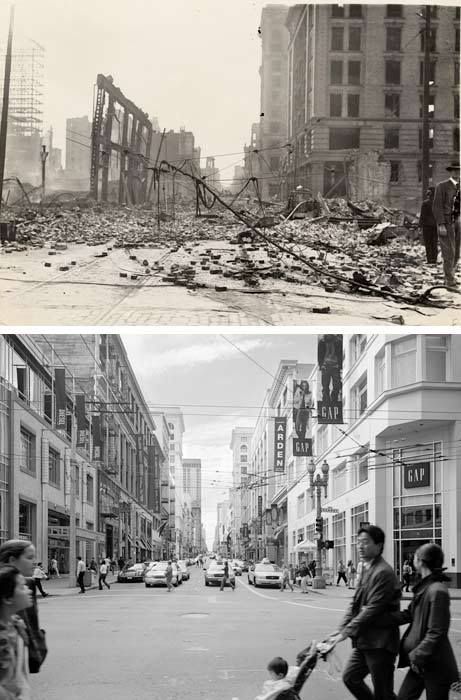
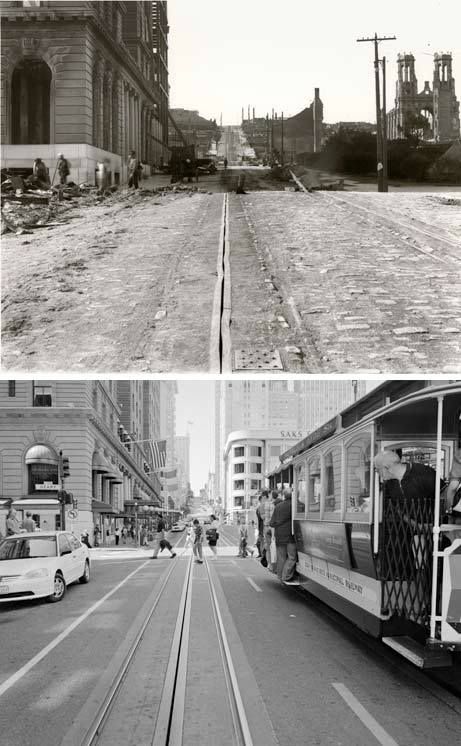
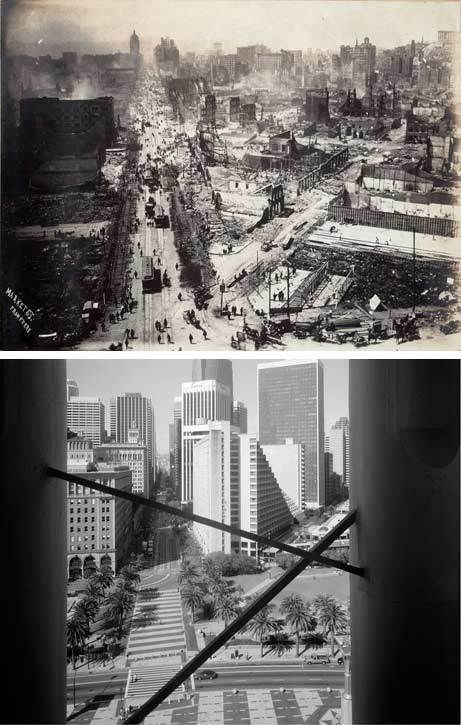













![Brotherhood" (2006) [TV-Series]](http://photos1.blogger.com/x/blogger2/1421/379621144723082/211/z/425926/gse_multipart33129.jpg)







No comments:
Post a Comment